Or: RVing Off The Grid, At Last!
Finally. It feels good to be boondocking and fully self contained once again. After testing out the RV solar power system we installed on the new rig a couple weeks ago, I figure it’s time to share some tips about what to expect with solar power for RVs and other considerations for anyone, well…considering installing solar panels on their RV.
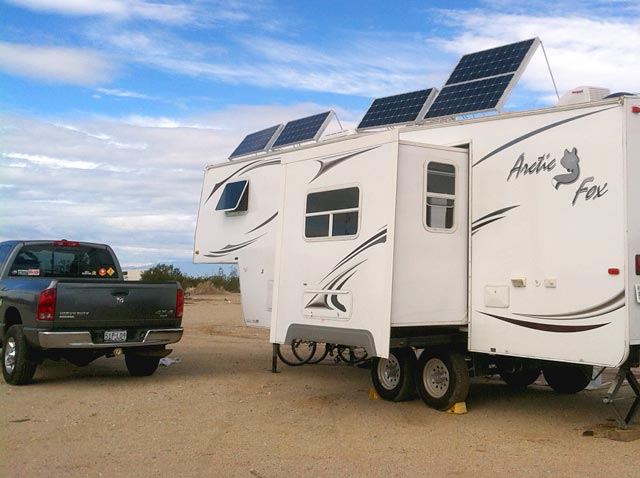
I reheated my coffee in the microwave this morning. That may not sound like a big deal to most full-time RVers, but it’s a big deal here in the mobile Agreda headquarters. But wait, there’s more! This was after Rene had used her flat iron to style her hair, something she doesn’t normally do without being plugged in to shore power. We also had our laptops charging and the network online. By the time I finished my still hot coffee, our batteries were back up to 14.4 volts, and fully charged in Float mode within another hour or so.
What does all this mean?
In short, our new RV solar power equipment rocks! It was well worth the investment. Simply put, it works for us. Considering we work online full-time, have various devices to keep charged, and enjoy boondocking and living (way) off the grid most of the time; it works well indeed. Your needs may differ.
I won’t get in too deep about watts, amp hours and voltage here. Plenty of others have written about these things in great detail before:
- RV Solar System Custom Design Worksheet
- Calculating system size by actual use.
- Why and how to perform an energy audit?
- How to specify the best RV solar power to meet your needs.
- Why tilt your solar panels?
- RV solar power basics and DIY kits.
- Maximum Power Point Tracking & MPPT Charge Controllers
Instead, I’ll just present a few observations about our new system and its installation. In some cases, the best way I can do this is to make some comparisons with the solar power on our old trailer.
First, The Specs…
Previously, the system we installed on our Arctic Fox 245N included two solar panels for a total of 250 watts, a residential style 2400w inverter/charger, charge controller with remote and two 12v batteries. While this enabled us to work and enjoy our lifestyle, we would often need to use our generator to keep the batteries topped off after hours.
Primary components of our new RV solar power system include:
- Renogy 100w Solar Panels
(QTY: 5 = 500 watts total)
- Solar Boost SB3000 MPPT Charge Controller
- Blue Sky IPN Remote Display
- Xantrex ProWatt 2000 Pure Sine Wave Inverter
- Trojan T105-Plus 6v Batteries
(QTY: 4)
- Automatic Transfer Relay Switch
Now, we haven’t run the generator more than twice since installing our new system. And, that was only to test our charge controller and transfer relay switch!
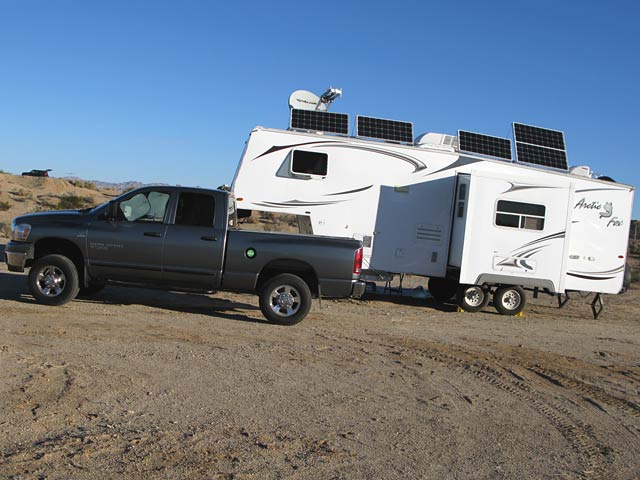
Observations So Far
First impressions of our new RV solar power…
I used to say, “If I go to bed with 12v in the batteries I’m happy.” This is no longer a concern with our new .5 kilowatt system and larger battery bank! I’ve yet to see the batteries drop below 12.4v± even after working late into the night. The IPN Remote Display has consistently indicated the batteries are in acceptance/absorption mode at 14.4v by 9:00 a.m. or earlier every day.
FYI: The Solar Boost SB3000 is a three-stage controller that optimizes battery charging in three phases.
- Bulk: Batteries are provided with as maximum available current to rapidly charge batteries
- Acceptance: Current is reduced to maintain batteries at 14.4v until fully charged
- Float: Lower voltage (13.2v default) is applied to keep batteries fully charged without excessive water loss.
It’s nice to wake up and see 12.7v on the display. It’s even nicer to see our array generating more than 30 amps! And it’s even sweeter yet to charge our computers, and run the blender or other appliances, without drastic voltage loss or having to run the generator.
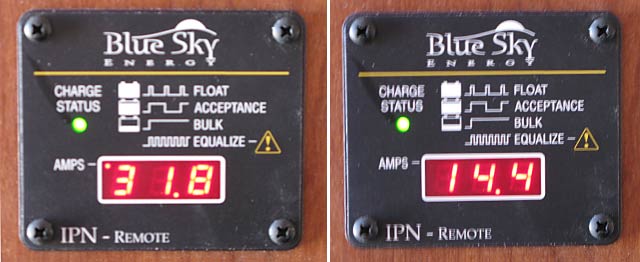
What else has this new system let us do? Yesterday we vacuumed the place without plugging into the generator first. We run fans without worry, and while it’s hard not to get obsessive about watching watts and voltage, we spend much less time in the dark.
Technical Expectations
Random thoughts about RV solar power system installation and use…
Design A System That Meets Your Needs
You can’t expect to run all of your electrical appliances—the microwave, television, air conditioning, etc.—all day, and into the night, on solar power. Well, you can, but if you do, you can expect to spend a lot of money, IF you have room for the equipment required! It’s better to accurately determine your actual usage and install a system that meets your needs. The best way to do that is with a detailed solar power energy audit.
Calculations are relatively simple: Multiply the average current (draw) of electrical appliances times the amount of hours each is used per day to determine amp hours consumed. Total all amp hours required to determine the number of panels required.
Appliance: DC Amps@12v x Hours per Day = Daily Amp Hours Consumed
NOTE: Multiply AC Amps x 10 to get DC amp draw from batteries (Example: 5 amp AC = 50 amp at 12VDC)
Size Matters
Roof space and storage areas are precious commodities in most RVs. Expect physical limitations when designing your dream system. You may just not have the roof space required for larger panels. That’s why we chose the Renogy 100w panels. They may only be 100 watts, but at just 47″ x 21″ they offered the highest amperage rating for their footprint, and provided the most flexibility when positioning them on our roof.
We literally could have fit just one larger 245w panel on the roof of our fifth wheel. By spreading the smaller panels out, and mounting two of them together, we have a .5 kilowatt system and can still move around the roof comfortable when needed.
The same goes for batteries. Most RV battery compartments are not designed to hold the amount of batteries required to make a true off-grid rig. We relocated our battery bank, and opted for the 6v Trojan batteries which provide more amp hours—and should last up to twice as long as typical 12v batteries—in the same space.

You Get What You Pay For
You can expect to pay more for an MPPT charge controller and true sine wave inverter, but you’ll be glad you did. While our panels are rated with an Optimum Operating Current of 5.29 amps, we’re consistently seeing 6± amps each thanks to the Maximum Power Point Tracking provided by the Solar Boost MPPT Controller.
The ProWatt Ture Sine Wave Inverter provides continuous and consistent power for both our sensitive electronic devices, and the variable speed power tools Rene uses in her mobile jewelry workshop.
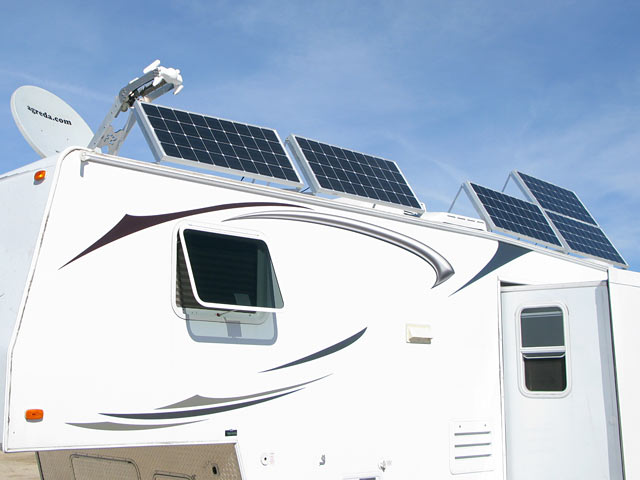
Tilt Panels for Maximum Output
There are many RVers who would rather never get up on their roof. Others believe that tilting solar panels is not worth the effort. I for one, don’t mind taking the few minutes it takes to tilt our panels to see up to a 200% increase in amps generated. By mounting the panels with brackets and supports that can easily be extended, I can point them for more direct exposure. The first time I raised our new panels, the controller displayed approx. 10A before doing so. After tilting the panels, we were generating 25+ amps, and it was early in the morning!

Expect To Do Some Damage
Whether you do it yourself or have the system installed, be prepared to cut some holes in your rig and do some unexpected remodeling. We had Solar Mike at The Sun Works complete our install in one day. But for that day, our rig looked like a battle zone. Had I done it all myself, I may have taken a week! I also made some cabinetry modifications to relocate our battery bank, and added a few new holes in the floor and walls after being unable to pull wiring where desired.
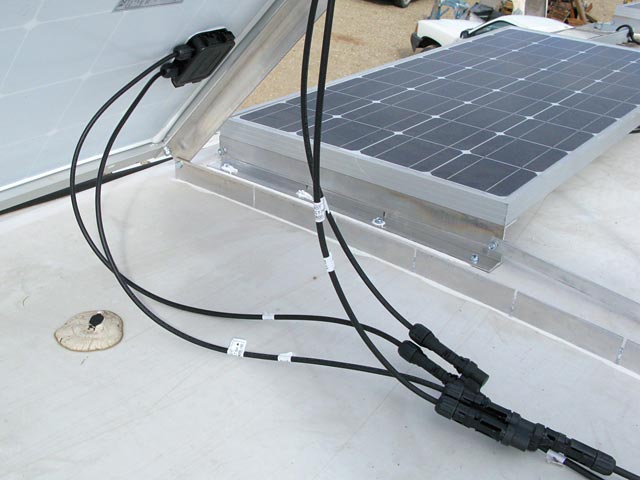
Do Not Expect To Use “Solar Ready” RV Wiring
Arctic Fox, and I’m sure many other RV manufacturers, promote their rigs as “Solar Ready” because they run wiring through a port in the roof to accommodate adding solar power at a later date. This wiring is clearly designed for low voltage trickle charging to keep batteries maintained for weekend use.
I can’t imagine what would happen if we tried to push 30 amps through the pre-wired cabling in our rig. Well, I can, but I’d rather not. Our five solar panels connect to 6 gauge parallel battery cable—capable of safely transmitting the higher current, and much thicker than the solar-ready wiring. This required finding a new route for the heavier cable.

Lifestyle Considerations
So, how’s that RV solar power workin’ out for you?
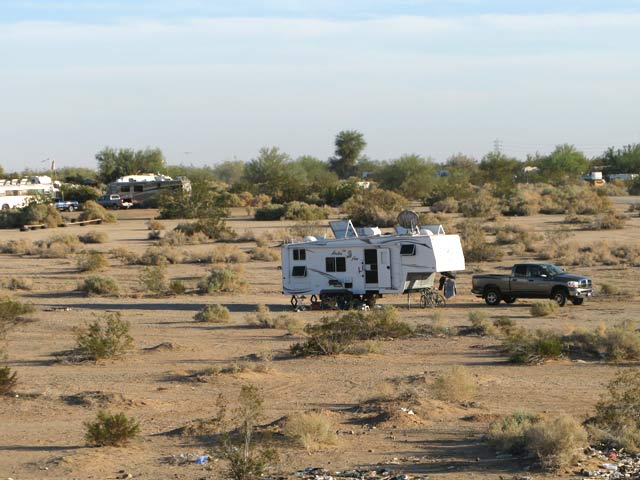
Is RV Solar Power Right For You?
This is the most important question every RVer should ask before ever considering installing solar power. The bottom line is this: Why do you want solar power, and what’s it worth to you?
If you prefer boondocking and enjoying living in your RV off the grid, then go for it! Do you pay attention to power consumption? Do you mind monitoring your usage? Or, would you rather be plugged in with all the comforts of home and no worries in RV parks all the time? Solar power makes it possible for us to work from anywhere. And we prefer working from some pretty remote places, so it’s a must.
Unfortunately the first question most people ask us about solar is, “What’s it cost?”
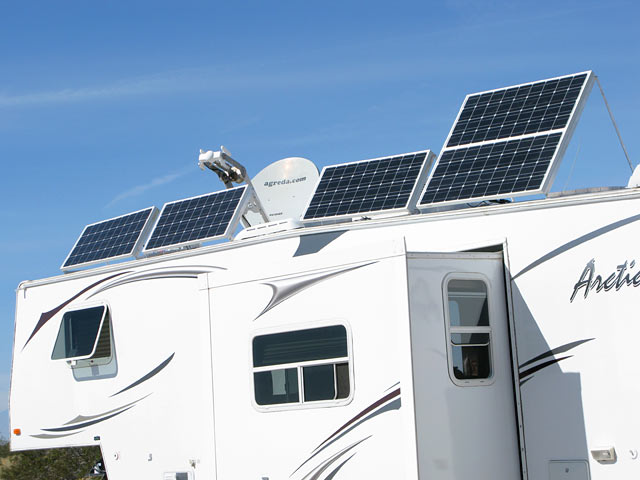
What’s It Cost?
Sigh…we used to hear this all the time in our previous life at the graphics shop. My answer would always be, “What’s your budget?” My mother used to say, “If you have to ask, you can’t afford it.” While both these answers may sound sarcastic, they are both suitable when it comes to pricing solar power for your RV.
Research indicates that average cost of solar power ranges from $4 to $7 per watt. If cost is your first question, solar may not be for you. It would be better to ask yourself why you want solar power. Then, price a system that meets your needs. For our lifestyle, solar power is a bare necessity. And we have vowed not to pay for an RV site, for at least 130 nights, to pay for our new system.
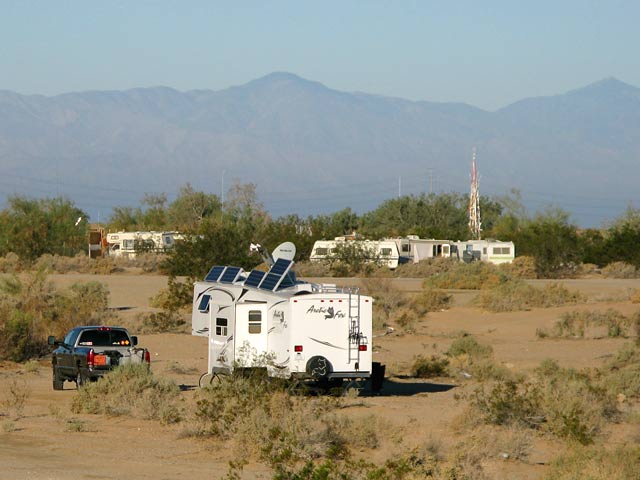
Keep It Simple
Another benefit of our new system is its ease of use. By installing a Transfer Relay switch, all we have to do now to use solar power is turn on the inverter. There is nothing to do when we plug in at an RV park, or if we plug into our generator. Basically, the relay switch is always on, instantly providing power from the inverter. It automatically senses AC power from an external source, and will switch to shore power after a short delay whenever plugged in.
With our previous system, we charged the batteries through the inverter. This required physically plugging into the inverter, until I wired a separate breaker switch into the distribution panel. Even then, we would lose power to any outlets on the Converter circuit which we had to turn off. Now we use the Converter for charging and the relay switches the power source automatically.

Note To Self
Set the fridge to LP mode! While I am now pretty much ecstatic about our new solar power, for the first couple days after the installation I had some concerns. It just didn’t seem to be doing the job, for the size of the array and battery bank. It was about day four when I realized the fridge was still set on Auto mode. This means that the every time we turned on the inverter, the refrigerator would switch to use AC power. After setting the fridge to LP only, we’ve seen a noticeable improvement in our energy reserves. But, as Solar Mike said, “You were saving propane!”
Any Questions?
Other than how much it costs!
Subscribe For Updates
Get notified of future blog posts and receive a free gift.
Hi! Thanks for all the information!
Can adequate energy be obtained from panels tilt-mounted at ground level? We’ve had a previous TT with water damage that rotted out the floor so cringe at the thought of anyone putting holes in the roof of our new TT. How accommodating are panels to stowing when traveling and how heavy are they? We have no ladder so no access to the roof. We’d like to start visiting national parks which apparently have no electricity.
Thanks in advance for any suggestions you or others may have.
Great questions…”adequate energy” is relative to the number of panels and there exposure to direct sunlight throughout the day, which will depend upon their position relative to the horizon. Tilting certainly helps! “How accommodating” depends upon the size of panel(s) and your amount of storage space.
My best suggestion would be to do an energy audit to determine your actual needs, and reconsider the frustration factor involved with setting up and stowing your array wherever you go…
I have a couple questions. To preface them I also have an Arctix Fox, a 2018 29-5T and I’m getting ready to do a solar install of maybe 600 watts with 4 6 volt LifeLine AGM batteries. I anticipate our full-timing lifestyle will use a similar amount of power to yours.
Regarding your 500 watt system, I didn’t see that you had installed a battery montior such as the Trimetric 2030. (Did I miss that?) Do you know how deeply you are discharging your batteries and if you are replacing all the electricity with your solar. A friend of mine suspects you may be draining your batteries beyond 50% and shortening their lives as a result. What can you say about this? Thanks.
You bring up a good point Russ, but battery bank discharge is not a concern for us. We do not have a battery monitor system that provides as much detail as the Trimetric or comparable products. While that would be a nifty gadget to have, our charge controller has a remote display that provides ample information regarding our usage and status of the batteries at any given time. We have also learned to be good (and smart) stewards of our batteries, and have rarely depleted the charge to less than 70%±.
Of course, for anyone whose usage demands ride closer along the fine line of recommendations for their specified system, more attention to detail would be a big benefit, if such a monitor is within the install budget.
Are you saying that your battery voltage has rarely fallen below 12.3 volts based on the Blue Sky remote? Even first thing in the morning on a cold day before the sun has hit your panels and charging begun?
Separately, at what voltage do your charge your T-105 Plus batteries during the absorption stage?
Thanks.
Yup. I can’t remember the last time I let our battery bank drop below 12.4, but whenever it got into that range, I would charge up via our portable generator.
Jim
I have a Sandpiper 5iver. It has a residential frig inside & beer frig outside. I have a 3000 watt Xantrex inverter/charger. I would like to do more boondocking. I have 4 Trojan T105 batteries. I plan on adding a solar system like yous. Roof space is not a problem, I have roughly 42 feet up there. My wife & I planing on retiring soon & getting away from the cold winters here in Canada. Looking at AZ to hang the hat for winter. I hope this system will work for me. I can’t find watt/hours for either of my refrigerator’s. When we got the trailer it had a 1000 watt inverter for the indoor frig. I figured that a 3000 watt inverter should handle my power needs. We have 50 amp shore power but have only one AC. We have camped many times on 30 amps service with no problems.
Do you think a system like yours (500 watt) 30 amp mppt will keep up with me?
Jay from Canada
It should, but it all depends on your usage. We don’t have TV or any other major draws. With two fridges, I would definitely figure out what they draw to be sure. Thanks for asking!
This looks awesome! Know anyone in Colorado that could install a system like this?
Great question Melissa. I have no specific recommendations in Colorado, and only suggest that it will be worth your time to travel to someone who specializes in RV Solar power systems! RV Solar Electric in Scottsdale, AZ comes highly recommended and there is Solar Bill in Quartzsite. But we will likely always return to see Solar Mike at The Sun Works if we ever need more work done. Check the iRV2 and RV.net forums for more feedback.
Hi Jim and Rene,
We are glad we found you. We just bought a new to us 2007 AF 24-5N. The plan is to start fulltiming Jan/Feb 2016.
The rig we bought has two older 12v batteries (which have likely reached their life span) with the original PD9200 power converter. I am a fifth-wheel and solar beginner but from what I have learned so far I think a solar system a little smaller than yours would work for us. We are committed to fulltiming for two year or longer. That means in two years we will decide to keep the 24-5N or upgrade like you did. I think it would be great if we could build about half the solar system now (2 golf cart batteries, adequate converter-charger, inverter, solar panels and a generator) and expand in two years to the full system in the 24-5N or a slightly bigger rig. Because you guys had a 24-5N with a solar system I would be interested in hearing your opinion and advice. In advance I want to thank you for your help.
Hannes
Congratulations on the new rig, Hannes. We loved our 245-N! Our Specs Page still lists the components of its old solar power setup. Thanks for the reminder that we need o update that!
Check the dates on your batteries, you may not need to replace them just yet. We got four 6v batteries for our new system, but finding a place for those in the 245-N may tight and relocating them can be tricky. The two house batteries worked fine for us for 7± years. I’d suggest investing in a good controller and inverter, getting a couple panels, and upgrade the battery bank down the road. Be sure to review all our previous RV solar power posts for more information.
So, I think you forgot to answer the “how much does it cost?” question…. 🙂
You mentioned not plugging in for at least 130 nights to pay for your system…. hmmm, lets see 130 nights X $25.00 a night is $3,250.00. If you got that system installed for $3,250 consider it stolen! I installed a house system 20 years ago, with less solar (but more storage) that cost about to $15,000.00!
Very close! We figured $28/night including tax. 😉 A steal indeed.